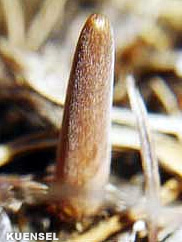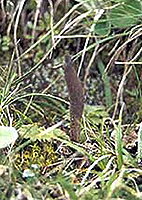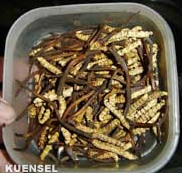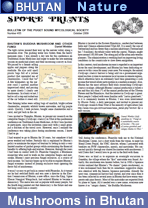| Cordyceps sinensis - Yartsa Goenbub in Bhutan |
| Highly
valued medicinal plant |
 |
Bhutan's Nature Yartsa Goenbub |
|
 |
Bhutan's Nature Information |
|
|
 |
| Yartsa Goenbup - Summer grass-winter worm |
 |
| Yartsa
Goenbub roughly translates as 'Summer Grass-Winter Worm' |
 |
 |
| Dr. Jones digs a fungus
Dr.
Nigel Hywel-Jones, insect pathologist and advisor to the agriculture ministry
on poaching problems with Yartsa Goenbub, and his research team studying
the fungus contributed this article.
Some
15 years ago few people in the west had heard of Cordyceps sinensis - literally
the Chinese Cordyceps. This is the scientific name for what is known in
Bhutan as Yartsa Goenbub. |
|
Yartsa
Goenbub roughly translates as 'Summer Grass-Winter Worm'. A 'grass' is
a plant while a 'worm' is an animal. Biologically, Yartsa Goenbub is neither.
It
is a fungus - related to a humble mushroom that we can buy in the market.
And related to a 'toadstool' that our parents told us, as children, was
deadly to eat, or even touch. Although not deadly to us, Yartsa Goenbub
is as deadly as the deadliest 'toadstool' to its insect host.
Fifteen
years ago, because of the success of Ma Junren's athletes in breaking middle
and long-distance world records, there was increased demand for the Chinese
Cordyceps. Ma Junren acknowledged that Yartsa Goenbub was an important
tonic for the athletes - improving physical performance.
Now,
a casual 'Google' for "Cordyceps sinensis" gives 8000+ internet hits! Many
westerners are adopting the more 'back-to-nature' approach of their ancestors.
Consequently, the last fifteen years has seen an increase in the demand
for 'alternative medicine'.
To
feed this demand there has been pressure on Yartsa Goenbub populations
which were traditionally harvested from the alpine grasslands of the Himalayan
Plateau. Most collecting was from Tibet, but more recently, Tibetan poachers
found it profitable to cross the border into Bhutan and steal this valuable
commodity. We can only guess at how much Yartsa Goenbub has gone out of
Bhutan in the last ten years and more.
The
discovery of Yartsa Goenbub is lost in the mists of time. But it is thought
that some yak herders noticed that when their yaks fed in particular areas
of grassland where the Yartsa Goenbub occurred, their yaks recovered more
quickly from the rigor of the harsh winter. The yak herders possibly started
collecting it and eating this themselves, finding that it gave them a boost
when walking in the mountains.
|
Cordyceps
sinensis |
 |
By
word-of-mouth, the detail of this wonder tonic eventually reached the Chinese
Royal Court about one thousand years ago. For hundreds of years Yartsa
Goenbub was used in Traditional Chinese Medicine.
But
only the Emperor and his immediate court could use it. It has only been
in the last few hundred years that it has trickled down to the ordinary
man on the street. But so expensive has it traditionally been, only the
well-off could afford Yartsa Goenbub.
Yartsa
Goenbub is not eaten on its own. In herbal medicine it is cooked with meat
(usually duck or chicken) to help lung, kidney and heart function. When
Yartsa Goenbub is cooked with pork it prevents impotence making it a natural
Viagra! Cordyceps sinensis can be found in herbalists' shops throughout
East Asia. I have seen it on sale in China, Hong Kong, Japan and Thailand.
Thai supermarkets sell small jars of 'chicken essence and Cordyceps' tonic
drink. However, it is the recent move into new markets (especially North
America and Europe) that has put a large strain on demand.
 |
| Cordyceps
Sinensis
Yartsa
Goenbub is a fungus that has learned how to invade and kill insects - it
is the HIV of the Insect World. The small brown fruit bodies emerge from
their winter dormancy around late May. The commercially valuable ones are
young fruit bodies before they make their spores. Late May and June is
therefore a good time for collecting these. As they mature over the next
four to six weeks they swell, producing millions of spores that are shot
from the fruit body to land on surrounding vegetation.
These
are then picked up by grazing caterpillars. The mature fruit bodies, shooting
their spores in late June and July, are biologically valuable - although
considered poor quality in the market. |
|
Spores
on the grazing caterpillars invade using enzymes. Once inside, Cordyceps
sinensis battles the insect immune system. If Cordyceps sinensis wins then
it slowly feeds on the fat reserves. The host is the larval stage (caterpillar)
of a moth.
The
caterpillars live under the soil feeding on the vegetation of the alpine
meadows. As they feed they store nutrients so they can make the change
from larva to pupa and finally to adult moth.
A
mature larva will pupate and develop in early spring. Healthy pupae emerge
as adults in the summer, so completing the life-cycle. The ones killed
by Cordyceps sinensis emerge, instead, as the valuable fruit bodies of
Yartsa Goenbub so completing the fungus' life-cycle. This relationship
between insect and fungus has been going on for millions of years - a relative
of Cordyceps sinensis was found in fifteen million year old Dominican amber
infecting an ant.
 |
Cordyceps Sinensis
There
are 400 species in the genus Cordyceps. Very few of these species have
been able to adapt to life in grasslands with most Cordyceps found deep
in dark, moist forest. Although Cordyceps sinensis is only found above
4000 metres in Bhutan there are certainly many tens of Cordyceps species
in Bhutan's tropical forest below 2000 metres. In Thailand there are over
120 Cordyceps species. |
|
 |
Many
infect caterpillars like Cordyceps sinensis. Others infect beetle larvae,
ants, wasps, termites and flies. Importantly, all Cordyceps (including
Cordyceps sinensis) are very specific in what they will infect. In alpine
grasslands, Cordyceps sinensis will only infect hepialid larvae. They can
not infect any of the tens of other species of moths and butterflies that
can be seen flying through these meadows in the summer months. But occasionally,
cross-over occurs - in much the same way that Bird Flu has crossed over
to humans. At some point a forest-dwelling Cordyceps, probably infecting
a relative of the alpine-meadow moth, moved out of the forest and into
the grassland.
What
is the future of Yartsa Goenbub in Bhutan? With the relaxing of previous
collecting bans, the last few years has seen a mini Klondike Gold Rush
into the hills of Bhutan. With my friend Mr. Tshitila of the Renewable
Natural Resources Centre (Yusipang) we have spent several seasons studying
the populations in the Soe and Lingzhi area of Northwest Bhutan.
With
support from Dr. Paul Cannon of CABI Biosciences we have been able to secure
three years research in the hills from the UK Government Darwin Initiative.
Research will help us to more fully understand the dynamics between the
fungus, the caterpillar and those collecting in the mountains.
 |
| This
article was contributed by KUENSEL, Bhutan's national newspaper 2006 |
| Mushrooms in Bhutan |
 |
|







